Hulk of OS 35 Departs Gibraltar for Recycling
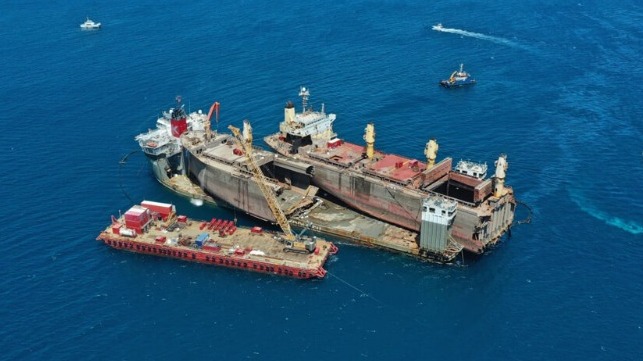
Eleven months after striking a vessel at anchor, the hulk of the bulker OS 35 departed the Port of Gibraltar this morning, July 28, bound for Amsterdam. It brings to a close a difficult salvage operation that had drawn broad attention as the wreck lay close to the shore and a popular beach in Gibraltar.
“I’m delighted to confirm that the long and challenging operation to remove the wreck of the OS 35 from Gibraltar has been brought to a safe conclusion,” said John Ghio, the Captain of the Port of Gibraltar in a statement thanking everyone for their hard work. He confirmed that the vessel Fjord, carrying the wreck of the OS 35, departed British Gibraltar Territorial Waters in the early hours of this morning
The AIS signal for the heavy lift vessels shows it arriving in The Netherlands on August 7. The two sections of the vessel will be handed over for a recycling operation.
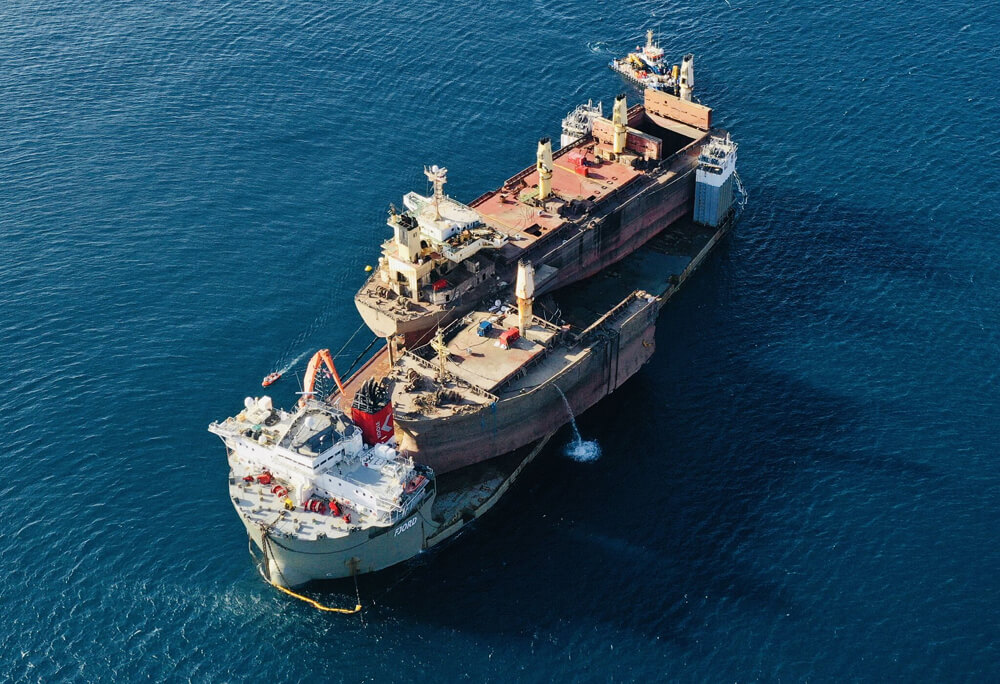
Koole Contracts which undertook the project highlighted that it went as planned and engineering. The 584-foot bulker first had to be offloaded of its cargo of steel rods. During the operation weather caused the vessel to break into two sections despite the decision early in the salvage effort to sink the stern to rest on the seabed.
In the last phase of the salvage operation, they were able to restore buoyancy to the stern and refloat it. It was anchored nearby with a crew working to maintain its buoyancy while the team focused on the more challenging part of lifting the bow section of the bulker. The lift began in late June and was completed in early July.
Koole has reactivated its semi-submersible barge the Fjord which had been idle and required more than two months of outfitting and classification certification before joining the project. The “sternless” design of the lift vessel meant she could accommodate an overhang on the stern so that both sections of the OS 35 could be positioned aboard using the 6,000 square meters of deck area on the Fjord. She has a deadweight capacity of 24,500 tons.
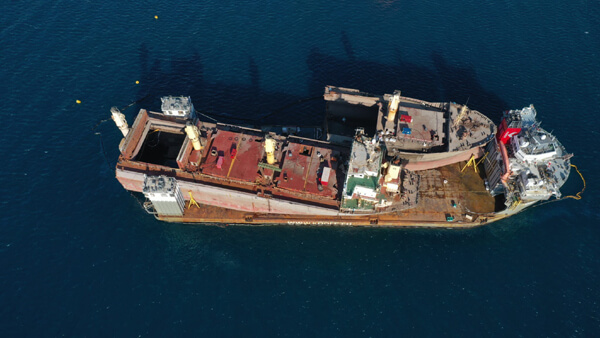
“I’d like to commend and congratulate the Captain of the Port on this final milestone in what has been a long and often challenging, but overall safe and successful salvage of the OS 35 wreck,” said Vijay Daryanani, Gibraltar’s Minister for the Port.
Officials said after the salvage operation was completed, they would continue to review the entire incident looking for lessons to be learned. The Port Captain has questioned some of the decisions and the communication between the OS 35 and the authorities after it struck an anchored gas carrier as the bulker was departing the port on August 30, 2022. The vessel as it was outbound was not required to have a pilot aboard. An analysis showed it hit the anchor chain of the Adam LNG tanker pulling her into the forward portion of the bulker.
Taking on water the bulker was ultimately directed to the position where she settled at the bow to the sea bed. The captain of the OS 35 recently pleaded guilty to charges related to the handling of the vessel and was given a suspended sentence in Gibraltar.
NTSB: Excessive Speed and Handling Issues Led to MSC Boxship-Tug Collision
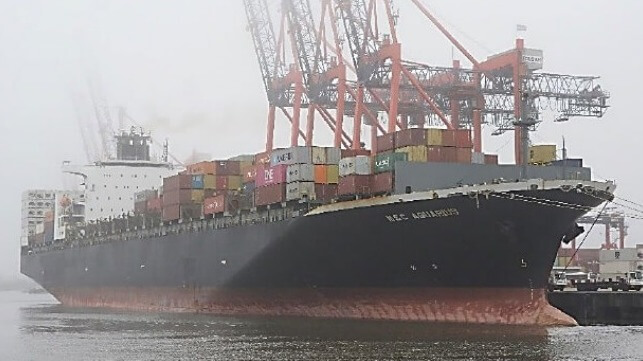
Excessive speed during a containership maneuvering in the Houston Ship Channel as it proceeded toward its dock along with hydrodynamic forces and handling of the tugboat led to a collision that resulted in nearly $1 million of damages. A newly released report from the National Transportation Safety Board highlights these issues during the preparation to dock the MSC Aquarius (6,500 TEU) in Houston on April 14, 2022, using the information to highlight the importance of communication and following guidelines for speed during maneuvering.
The 983-foot containership registered in Cyprus arrived in Galveston Bay and shortly after midnight on April 14 boarded a pilot from the Houston Pilots to proceed to the Barbour’s Cut Container Terminal at the north end of Upper Galveston Bay. The containership was traveling at a speed of 11 to 12 knots as it was inbound.
Two tugboats were assigned to assist the containership in docking. The maneuver called for the vessel to be turned in the main channel before backing into Barbour’s Cut. The pilot determined that two tugs would be sufficient for the operation with one at a forward position and the other aft.
The George M, owned by Bay-Houston Towing Co. and operated by G & H Towing Company, was assigned the forward position for the maneuver. The tug, built in 2021, was reported to have a top speed of 13 knots and 11 to 12 knots astern. At the time of this maneuver, the George M was under the command of its mate, an individual with 15 years of experience but working his first rotation on the vessel. He had been aboard for 24 hours and on the prior day the vessel assisted three vessels’ movements before being assigned to the MSC Aquarius. The captain of the tug was not on watch and was asleep when the assignment came for the containership.
The George M and the other tug met the MSC Aquarius at 0330 south of Morgan’s Point and were traveling at just under 10 knots as they made their way to the vessel’s berth. Assigned the forward position in the docking maneuver, the George M was required to come into a position bow-to-bow with the cargo ship to secure the hawser.
During this operation, the NTSB reports the tug began to move off centerline from the containership’s bow. The mate at the controls of the tug increased engine speed but found the tug was “a little slower” to get propulsion engine power than what he expected so he added more engine power attempting to regain position. When the power kicked in the tug veered across the bow of the containership and its starboard bow struck the starboard bow of the containership. The mate attempted to work the tug back toward the centerline and reported that the tug’s speed slowed despite being put to full power.
The George M collided a second time with the containership damaging the tug’s port propulsion unit. It then slid alongside the port side of the MSC Aquarius becoming lodged in the flair of the containership’s bow. The master of the George M had come to the bridge and was able to dislodge the tug. The tug sustained a collapsed mast, damaged railings, and an indention of the deck above the wheelhouse. There was a small breach in the area of the bulbous bow of the containership. Repairs to the tug cost approximately $750,000 while the containership sustained more than $180,000 in damages.
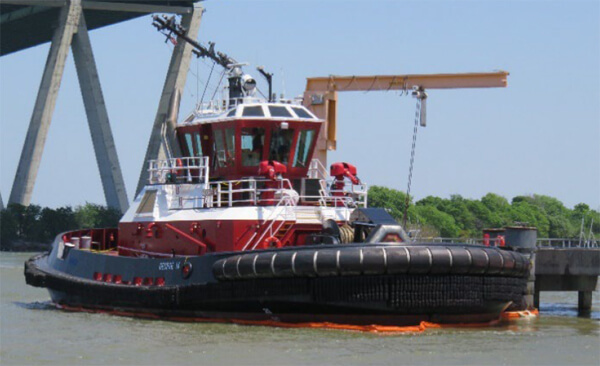
George M after the collision (USCG photo)
The NTSB in its analysis of the collision finds that there was a blind sector from the bridge of the containership preventing the pilot and bridge crew from seeing what was going on with the tug. The pilot said their first indication of a problem was when they got a frantic radio call from the containership’s bow crew. The pilot then began to slow the containership and when they did not get a response from the George M ultimately slowed and ordered the stern tug to pull.
The NTSB concludes the collision was due to speed and operating beyond the safety parameters and reserve power recommendations. The speed of the containership was 2.7 knots above the towing-company-directed limit and 3.7 to 6 knots above the limit preferred by pilots, tugboat captains, and ship masters surveyed by an international tug masters association. The mate commanding the tug did not communicate with the pilot on the containership and did not request that they slow the vessel before beginning the maneuver.
Hydrodynamic forces created during the maneuver also impacted the ability of the tug to maneuver. The NTSB highlights that even a few knots of speed would have a significant effect on the forces acting on the tugboat in the center lead position.
After the incident, the tug company developed new performance assessment records and recommendations. The NTSB also recommended that tugboat operators in general should determine and communicate pre-determined speed limits to ship masters or pilots commanding vessels they are assisting before engaging in maneuvers.
No comments:
Post a Comment